International Marketing Plan: Strategies for Soft Drinks in China
VerifiedAdded on 2020/06/05
|9
|3190
|80
Report
AI Summary
This report provides a comprehensive international marketing plan for a global soft drinks brand, specifically focusing on the Chinese market. It begins with an executive summary and proceeds with a detailed PEST analysis, evaluating the political, economic, social, and technological factors influencing the business environment. A SWOT analysis identifies the strengths, weaknesses, opportunities, and threats relevant to the brand's operations in China. The report then explores the competitive landscape, highlighting key competitors and their strategies. It analyzes various market entry strategies, including licensing, franchising, joint ventures, and wholly owned subsidiaries, recommending the most suitable approach. The report also covers positioning strategies, emphasizing the importance of creating a distinctive brand image. Marketing objectives are defined using the SMART framework, followed by a discussion of the marketing strategy, including target market identification (youth in China), product considerations (smoothies), pricing, promotion, and distribution. The report concludes by providing a detailed marketing mix to achieve the marketing objectives, offering actionable recommendations for the brand's success in the Chinese market.

MARKETING
Paraphrase This Document
Need a fresh take? Get an instant paraphrase of this document with our AI Paraphraser
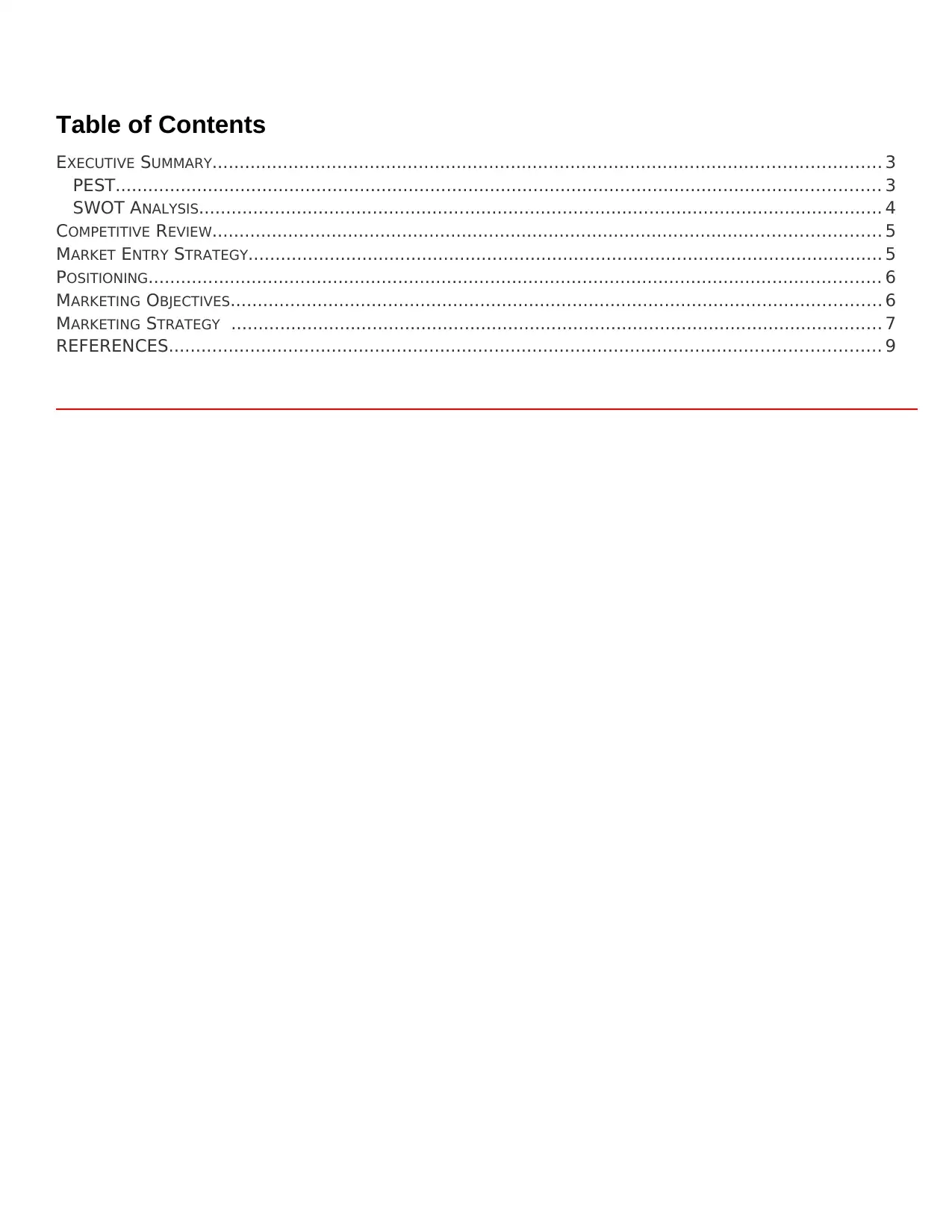
Table of Contents
EXECUTIVE SUMMARY........................................................................................................................... 3
PEST............................................................................................................................................. 3
SWOT ANALYSIS.............................................................................................................................. 4
COMPETITIVE REVIEW........................................................................................................................... 5
MARKET ENTRY STRATEGY..................................................................................................................... 5
POSITIONING....................................................................................................................................... 6
MARKETING OBJECTIVES........................................................................................................................ 6
MARKETING STRATEGY ........................................................................................................................ 7
REFERENCES................................................................................................................................... 9
EXECUTIVE SUMMARY........................................................................................................................... 3
PEST............................................................................................................................................. 3
SWOT ANALYSIS.............................................................................................................................. 4
COMPETITIVE REVIEW........................................................................................................................... 5
MARKET ENTRY STRATEGY..................................................................................................................... 5
POSITIONING....................................................................................................................................... 6
MARKETING OBJECTIVES........................................................................................................................ 6
MARKETING STRATEGY ........................................................................................................................ 7
REFERENCES................................................................................................................................... 9
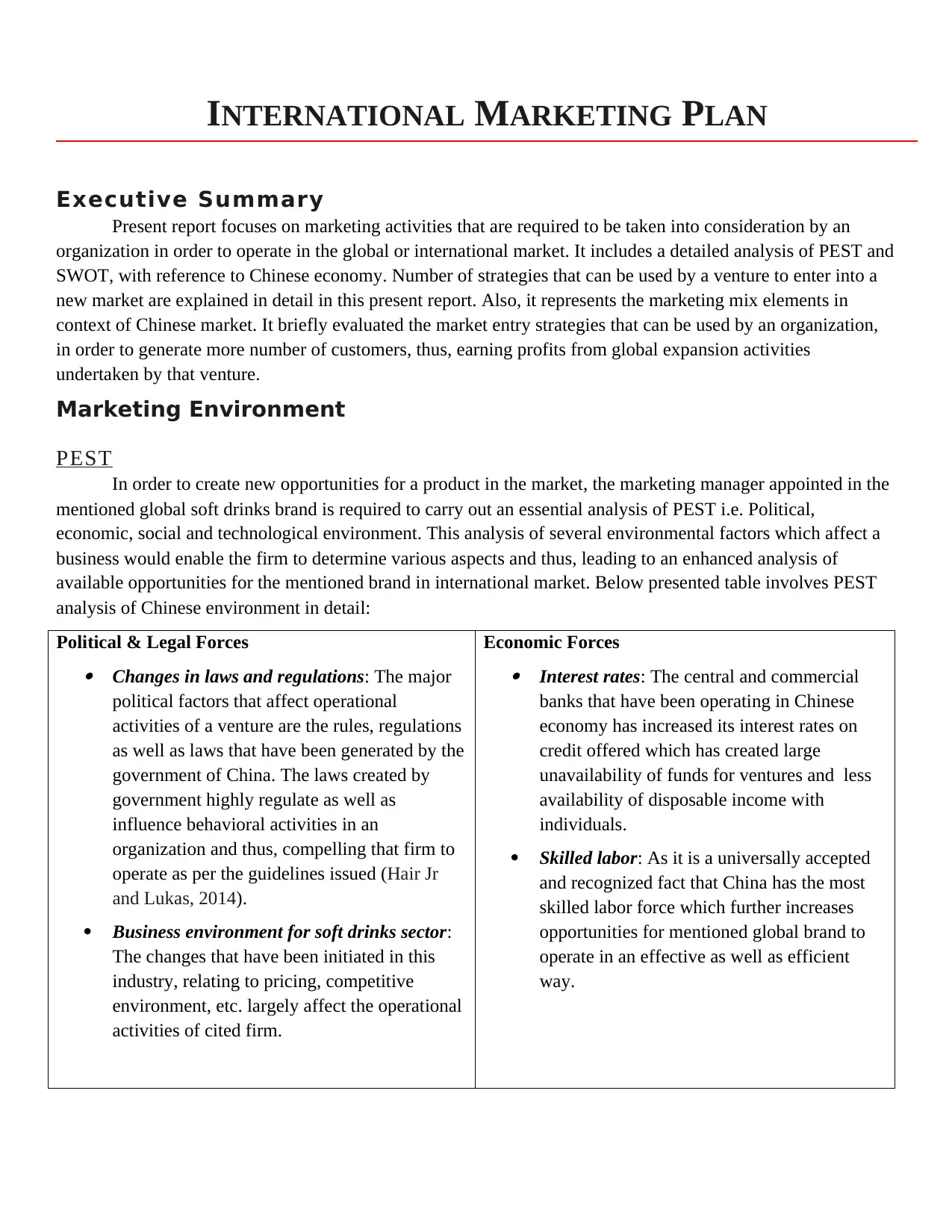
INTERNATIONAL MARKETING PLAN
Executive Summary
Present report focuses on marketing activities that are required to be taken into consideration by an
organization in order to operate in the global or international market. It includes a detailed analysis of PEST and
SWOT, with reference to Chinese economy. Number of strategies that can be used by a venture to enter into a
new market are explained in detail in this present report. Also, it represents the marketing mix elements in
context of Chinese market. It briefly evaluated the market entry strategies that can be used by an organization,
in order to generate more number of customers, thus, earning profits from global expansion activities
undertaken by that venture.
Marketing Environment
PEST
In order to create new opportunities for a product in the market, the marketing manager appointed in the
mentioned global soft drinks brand is required to carry out an essential analysis of PEST i.e. Political,
economic, social and technological environment. This analysis of several environmental factors which affect a
business would enable the firm to determine various aspects and thus, leading to an enhanced analysis of
available opportunities for the mentioned brand in international market. Below presented table involves PEST
analysis of Chinese environment in detail:
Political & Legal Forces
Changes in laws and regulations: The major
political factors that affect operational
activities of a venture are the rules, regulations
as well as laws that have been generated by the
government of China. The laws created by
government highly regulate as well as
influence behavioral activities in an
organization and thus, compelling that firm to
operate as per the guidelines issued (Hair Jr
and Lukas, 2014).
Business environment for soft drinks sector:
The changes that have been initiated in this
industry, relating to pricing, competitive
environment, etc. largely affect the operational
activities of cited firm.
Economic Forces
Interest rates: The central and commercial
banks that have been operating in Chinese
economy has increased its interest rates on
credit offered which has created large
unavailability of funds for ventures and less
availability of disposable income with
individuals.
Skilled labor: As it is a universally accepted
and recognized fact that China has the most
skilled labor force which further increases
opportunities for mentioned global brand to
operate in an effective as well as efficient
way.
Executive Summary
Present report focuses on marketing activities that are required to be taken into consideration by an
organization in order to operate in the global or international market. It includes a detailed analysis of PEST and
SWOT, with reference to Chinese economy. Number of strategies that can be used by a venture to enter into a
new market are explained in detail in this present report. Also, it represents the marketing mix elements in
context of Chinese market. It briefly evaluated the market entry strategies that can be used by an organization,
in order to generate more number of customers, thus, earning profits from global expansion activities
undertaken by that venture.
Marketing Environment
PEST
In order to create new opportunities for a product in the market, the marketing manager appointed in the
mentioned global soft drinks brand is required to carry out an essential analysis of PEST i.e. Political,
economic, social and technological environment. This analysis of several environmental factors which affect a
business would enable the firm to determine various aspects and thus, leading to an enhanced analysis of
available opportunities for the mentioned brand in international market. Below presented table involves PEST
analysis of Chinese environment in detail:
Political & Legal Forces
Changes in laws and regulations: The major
political factors that affect operational
activities of a venture are the rules, regulations
as well as laws that have been generated by the
government of China. The laws created by
government highly regulate as well as
influence behavioral activities in an
organization and thus, compelling that firm to
operate as per the guidelines issued (Hair Jr
and Lukas, 2014).
Business environment for soft drinks sector:
The changes that have been initiated in this
industry, relating to pricing, competitive
environment, etc. largely affect the operational
activities of cited firm.
Economic Forces
Interest rates: The central and commercial
banks that have been operating in Chinese
economy has increased its interest rates on
credit offered which has created large
unavailability of funds for ventures and less
availability of disposable income with
individuals.
Skilled labor: As it is a universally accepted
and recognized fact that China has the most
skilled labor force which further increases
opportunities for mentioned global brand to
operate in an effective as well as efficient
way.
⊘ This is a preview!⊘
Do you want full access?
Subscribe today to unlock all pages.

Trusted by 1+ million students worldwide
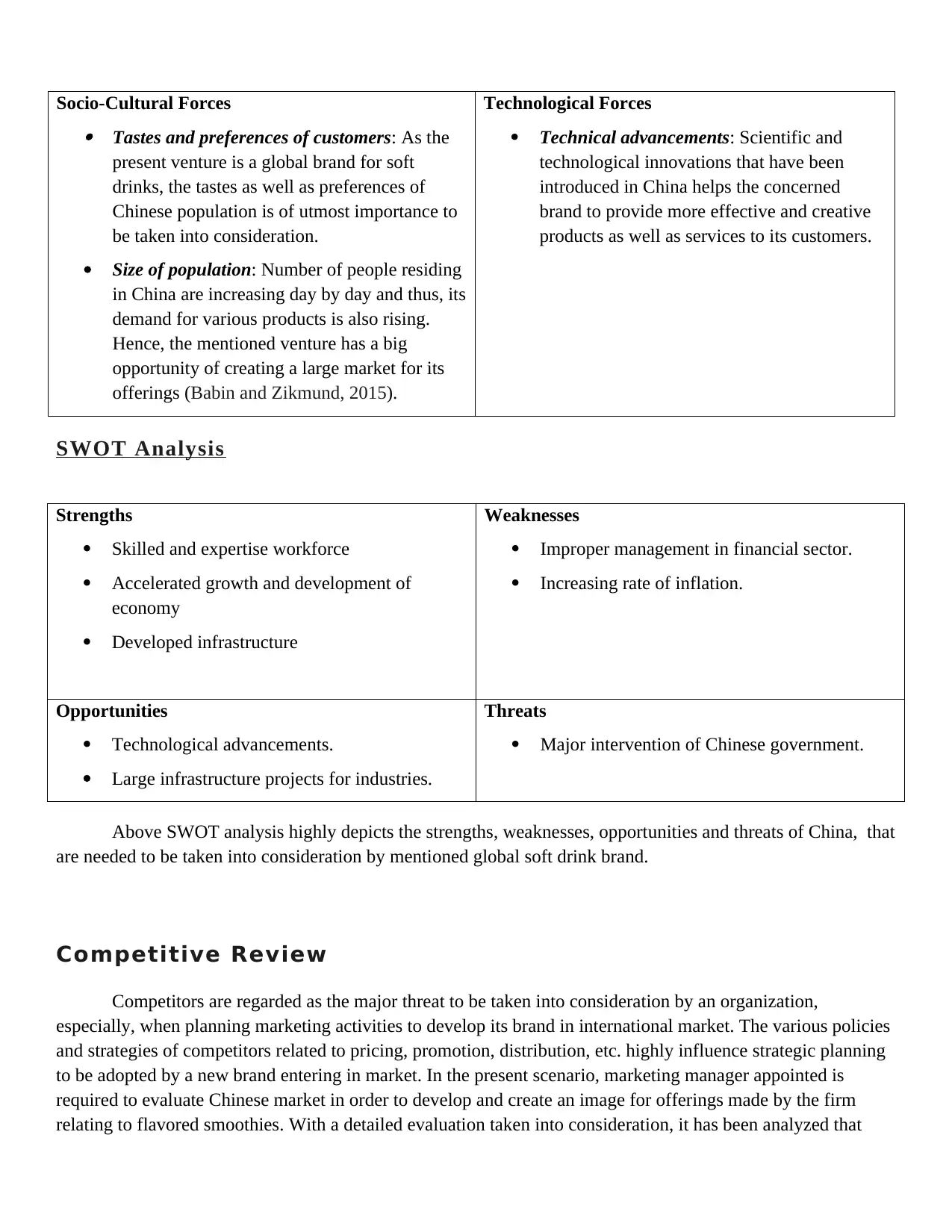
Socio-Cultural Forces
Tastes and preferences of customers: As the
present venture is a global brand for soft
drinks, the tastes as well as preferences of
Chinese population is of utmost importance to
be taken into consideration.
Size of population: Number of people residing
in China are increasing day by day and thus, its
demand for various products is also rising.
Hence, the mentioned venture has a big
opportunity of creating a large market for its
offerings (Babin and Zikmund, 2015).
Technological Forces
Technical advancements: Scientific and
technological innovations that have been
introduced in China helps the concerned
brand to provide more effective and creative
products as well as services to its customers.
SWOT Analysis
Strengths
Skilled and expertise workforce
Accelerated growth and development of
economy
Developed infrastructure
Weaknesses
Improper management in financial sector.
Increasing rate of inflation.
Opportunities
Technological advancements.
Large infrastructure projects for industries.
Threats
Major intervention of Chinese government.
Above SWOT analysis highly depicts the strengths, weaknesses, opportunities and threats of China, that
are needed to be taken into consideration by mentioned global soft drink brand.
Competitive Review
Competitors are regarded as the major threat to be taken into consideration by an organization,
especially, when planning marketing activities to develop its brand in international market. The various policies
and strategies of competitors related to pricing, promotion, distribution, etc. highly influence strategic planning
to be adopted by a new brand entering in market. In the present scenario, marketing manager appointed is
required to evaluate Chinese market in order to develop and create an image for offerings made by the firm
relating to flavored smoothies. With a detailed evaluation taken into consideration, it has been analyzed that
Tastes and preferences of customers: As the
present venture is a global brand for soft
drinks, the tastes as well as preferences of
Chinese population is of utmost importance to
be taken into consideration.
Size of population: Number of people residing
in China are increasing day by day and thus, its
demand for various products is also rising.
Hence, the mentioned venture has a big
opportunity of creating a large market for its
offerings (Babin and Zikmund, 2015).
Technological Forces
Technical advancements: Scientific and
technological innovations that have been
introduced in China helps the concerned
brand to provide more effective and creative
products as well as services to its customers.
SWOT Analysis
Strengths
Skilled and expertise workforce
Accelerated growth and development of
economy
Developed infrastructure
Weaknesses
Improper management in financial sector.
Increasing rate of inflation.
Opportunities
Technological advancements.
Large infrastructure projects for industries.
Threats
Major intervention of Chinese government.
Above SWOT analysis highly depicts the strengths, weaknesses, opportunities and threats of China, that
are needed to be taken into consideration by mentioned global soft drink brand.
Competitive Review
Competitors are regarded as the major threat to be taken into consideration by an organization,
especially, when planning marketing activities to develop its brand in international market. The various policies
and strategies of competitors related to pricing, promotion, distribution, etc. highly influence strategic planning
to be adopted by a new brand entering in market. In the present scenario, marketing manager appointed is
required to evaluate Chinese market in order to develop and create an image for offerings made by the firm
relating to flavored smoothies. With a detailed evaluation taken into consideration, it has been analyzed that
Paraphrase This Document
Need a fresh take? Get an instant paraphrase of this document with our AI Paraphraser
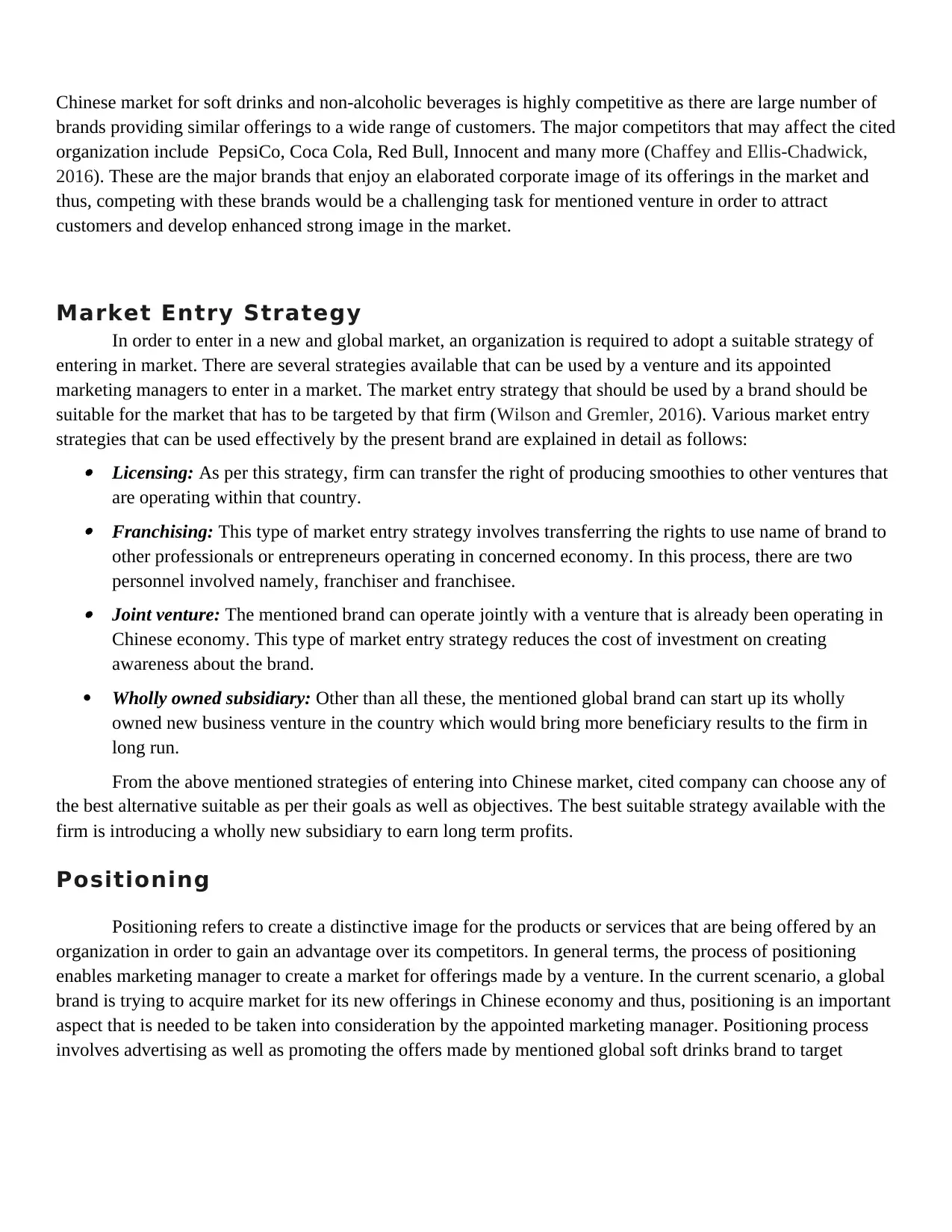
Chinese market for soft drinks and non-alcoholic beverages is highly competitive as there are large number of
brands providing similar offerings to a wide range of customers. The major competitors that may affect the cited
organization include PepsiCo, Coca Cola, Red Bull, Innocent and many more (Chaffey and Ellis-Chadwick,
2016). These are the major brands that enjoy an elaborated corporate image of its offerings in the market and
thus, competing with these brands would be a challenging task for mentioned venture in order to attract
customers and develop enhanced strong image in the market.
Market Entry Strategy
In order to enter in a new and global market, an organization is required to adopt a suitable strategy of
entering in market. There are several strategies available that can be used by a venture and its appointed
marketing managers to enter in a market. The market entry strategy that should be used by a brand should be
suitable for the market that has to be targeted by that firm (Wilson and Gremler, 2016). Various market entry
strategies that can be used effectively by the present brand are explained in detail as follows:
Licensing: As per this strategy, firm can transfer the right of producing smoothies to other ventures that
are operating within that country.
Franchising: This type of market entry strategy involves transferring the rights to use name of brand to
other professionals or entrepreneurs operating in concerned economy. In this process, there are two
personnel involved namely, franchiser and franchisee.
Joint venture: The mentioned brand can operate jointly with a venture that is already been operating in
Chinese economy. This type of market entry strategy reduces the cost of investment on creating
awareness about the brand.
Wholly owned subsidiary: Other than all these, the mentioned global brand can start up its wholly
owned new business venture in the country which would bring more beneficiary results to the firm in
long run.
From the above mentioned strategies of entering into Chinese market, cited company can choose any of
the best alternative suitable as per their goals as well as objectives. The best suitable strategy available with the
firm is introducing a wholly new subsidiary to earn long term profits.
Positioning
Positioning refers to create a distinctive image for the products or services that are being offered by an
organization in order to gain an advantage over its competitors. In general terms, the process of positioning
enables marketing manager to create a market for offerings made by a venture. In the current scenario, a global
brand is trying to acquire market for its new offerings in Chinese economy and thus, positioning is an important
aspect that is needed to be taken into consideration by the appointed marketing manager. Positioning process
involves advertising as well as promoting the offers made by mentioned global soft drinks brand to target
brands providing similar offerings to a wide range of customers. The major competitors that may affect the cited
organization include PepsiCo, Coca Cola, Red Bull, Innocent and many more (Chaffey and Ellis-Chadwick,
2016). These are the major brands that enjoy an elaborated corporate image of its offerings in the market and
thus, competing with these brands would be a challenging task for mentioned venture in order to attract
customers and develop enhanced strong image in the market.
Market Entry Strategy
In order to enter in a new and global market, an organization is required to adopt a suitable strategy of
entering in market. There are several strategies available that can be used by a venture and its appointed
marketing managers to enter in a market. The market entry strategy that should be used by a brand should be
suitable for the market that has to be targeted by that firm (Wilson and Gremler, 2016). Various market entry
strategies that can be used effectively by the present brand are explained in detail as follows:
Licensing: As per this strategy, firm can transfer the right of producing smoothies to other ventures that
are operating within that country.
Franchising: This type of market entry strategy involves transferring the rights to use name of brand to
other professionals or entrepreneurs operating in concerned economy. In this process, there are two
personnel involved namely, franchiser and franchisee.
Joint venture: The mentioned brand can operate jointly with a venture that is already been operating in
Chinese economy. This type of market entry strategy reduces the cost of investment on creating
awareness about the brand.
Wholly owned subsidiary: Other than all these, the mentioned global brand can start up its wholly
owned new business venture in the country which would bring more beneficiary results to the firm in
long run.
From the above mentioned strategies of entering into Chinese market, cited company can choose any of
the best alternative suitable as per their goals as well as objectives. The best suitable strategy available with the
firm is introducing a wholly new subsidiary to earn long term profits.
Positioning
Positioning refers to create a distinctive image for the products or services that are being offered by an
organization in order to gain an advantage over its competitors. In general terms, the process of positioning
enables marketing manager to create a market for offerings made by a venture. In the current scenario, a global
brand is trying to acquire market for its new offerings in Chinese economy and thus, positioning is an important
aspect that is needed to be taken into consideration by the appointed marketing manager. Positioning process
involves advertising as well as promoting the offers made by mentioned global soft drinks brand to target
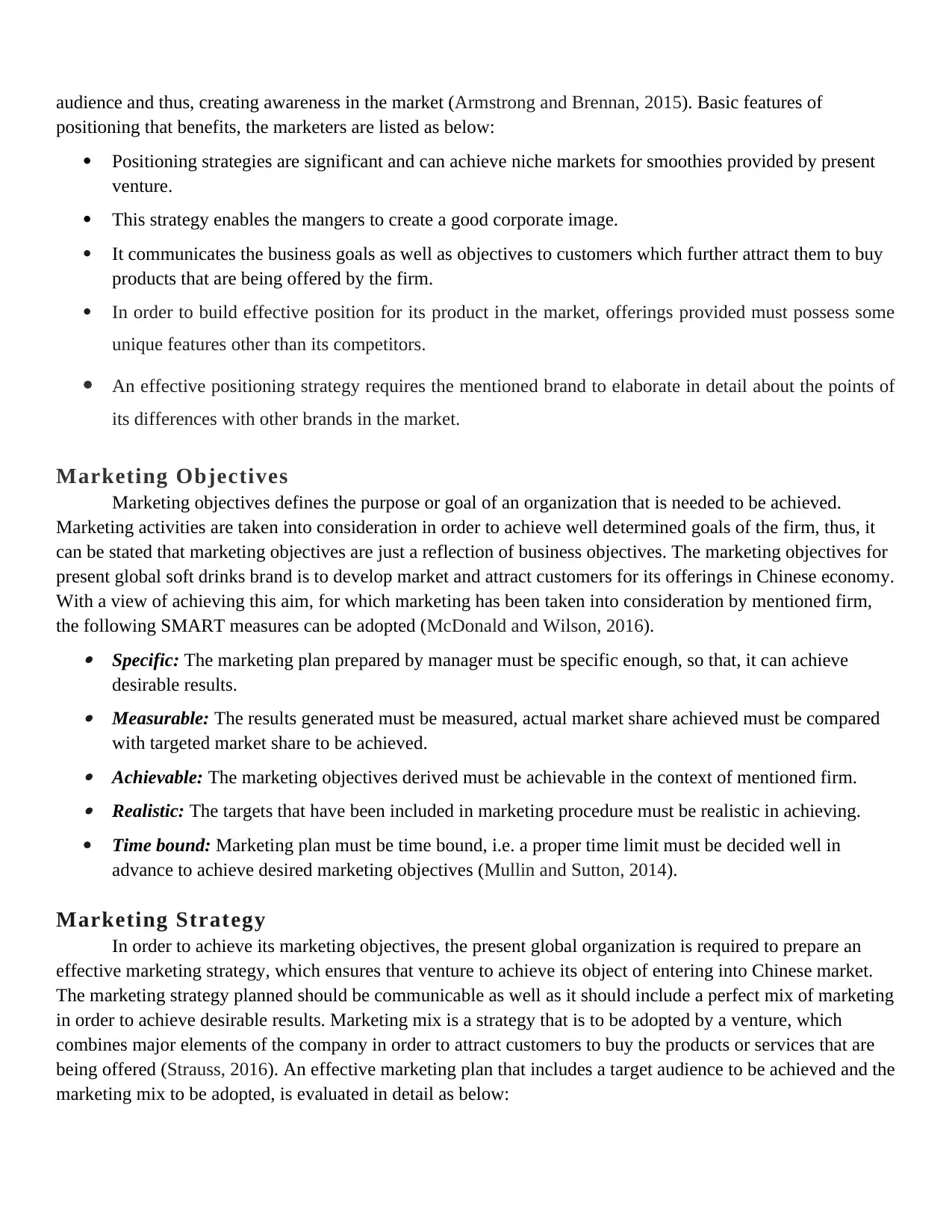
audience and thus, creating awareness in the market (Armstrong and Brennan, 2015). Basic features of
positioning that benefits, the marketers are listed as below:
Positioning strategies are significant and can achieve niche markets for smoothies provided by present
venture.
This strategy enables the mangers to create a good corporate image.
It communicates the business goals as well as objectives to customers which further attract them to buy
products that are being offered by the firm.
In order to build effective position for its product in the market, offerings provided must possess some
unique features other than its competitors.
An effective positioning strategy requires the mentioned brand to elaborate in detail about the points of
its differences with other brands in the market.
Marketing Objectives
Marketing objectives defines the purpose or goal of an organization that is needed to be achieved.
Marketing activities are taken into consideration in order to achieve well determined goals of the firm, thus, it
can be stated that marketing objectives are just a reflection of business objectives. The marketing objectives for
present global soft drinks brand is to develop market and attract customers for its offerings in Chinese economy.
With a view of achieving this aim, for which marketing has been taken into consideration by mentioned firm,
the following SMART measures can be adopted (McDonald and Wilson, 2016).
Specific: The marketing plan prepared by manager must be specific enough, so that, it can achieve
desirable results.
Measurable: The results generated must be measured, actual market share achieved must be compared
with targeted market share to be achieved.
Achievable: The marketing objectives derived must be achievable in the context of mentioned firm.
Realistic: The targets that have been included in marketing procedure must be realistic in achieving.
Time bound: Marketing plan must be time bound, i.e. a proper time limit must be decided well in
advance to achieve desired marketing objectives (Mullin and Sutton, 2014).
Marketing Strategy
In order to achieve its marketing objectives, the present global organization is required to prepare an
effective marketing strategy, which ensures that venture to achieve its object of entering into Chinese market.
The marketing strategy planned should be communicable as well as it should include a perfect mix of marketing
in order to achieve desirable results. Marketing mix is a strategy that is to be adopted by a venture, which
combines major elements of the company in order to attract customers to buy the products or services that are
being offered (Strauss, 2016). An effective marketing plan that includes a target audience to be achieved and the
marketing mix to be adopted, is evaluated in detail as below:
positioning that benefits, the marketers are listed as below:
Positioning strategies are significant and can achieve niche markets for smoothies provided by present
venture.
This strategy enables the mangers to create a good corporate image.
It communicates the business goals as well as objectives to customers which further attract them to buy
products that are being offered by the firm.
In order to build effective position for its product in the market, offerings provided must possess some
unique features other than its competitors.
An effective positioning strategy requires the mentioned brand to elaborate in detail about the points of
its differences with other brands in the market.
Marketing Objectives
Marketing objectives defines the purpose or goal of an organization that is needed to be achieved.
Marketing activities are taken into consideration in order to achieve well determined goals of the firm, thus, it
can be stated that marketing objectives are just a reflection of business objectives. The marketing objectives for
present global soft drinks brand is to develop market and attract customers for its offerings in Chinese economy.
With a view of achieving this aim, for which marketing has been taken into consideration by mentioned firm,
the following SMART measures can be adopted (McDonald and Wilson, 2016).
Specific: The marketing plan prepared by manager must be specific enough, so that, it can achieve
desirable results.
Measurable: The results generated must be measured, actual market share achieved must be compared
with targeted market share to be achieved.
Achievable: The marketing objectives derived must be achievable in the context of mentioned firm.
Realistic: The targets that have been included in marketing procedure must be realistic in achieving.
Time bound: Marketing plan must be time bound, i.e. a proper time limit must be decided well in
advance to achieve desired marketing objectives (Mullin and Sutton, 2014).
Marketing Strategy
In order to achieve its marketing objectives, the present global organization is required to prepare an
effective marketing strategy, which ensures that venture to achieve its object of entering into Chinese market.
The marketing strategy planned should be communicable as well as it should include a perfect mix of marketing
in order to achieve desirable results. Marketing mix is a strategy that is to be adopted by a venture, which
combines major elements of the company in order to attract customers to buy the products or services that are
being offered (Strauss, 2016). An effective marketing plan that includes a target audience to be achieved and the
marketing mix to be adopted, is evaluated in detail as below:
⊘ This is a preview!⊘
Do you want full access?
Subscribe today to unlock all pages.

Trusted by 1+ million students worldwide
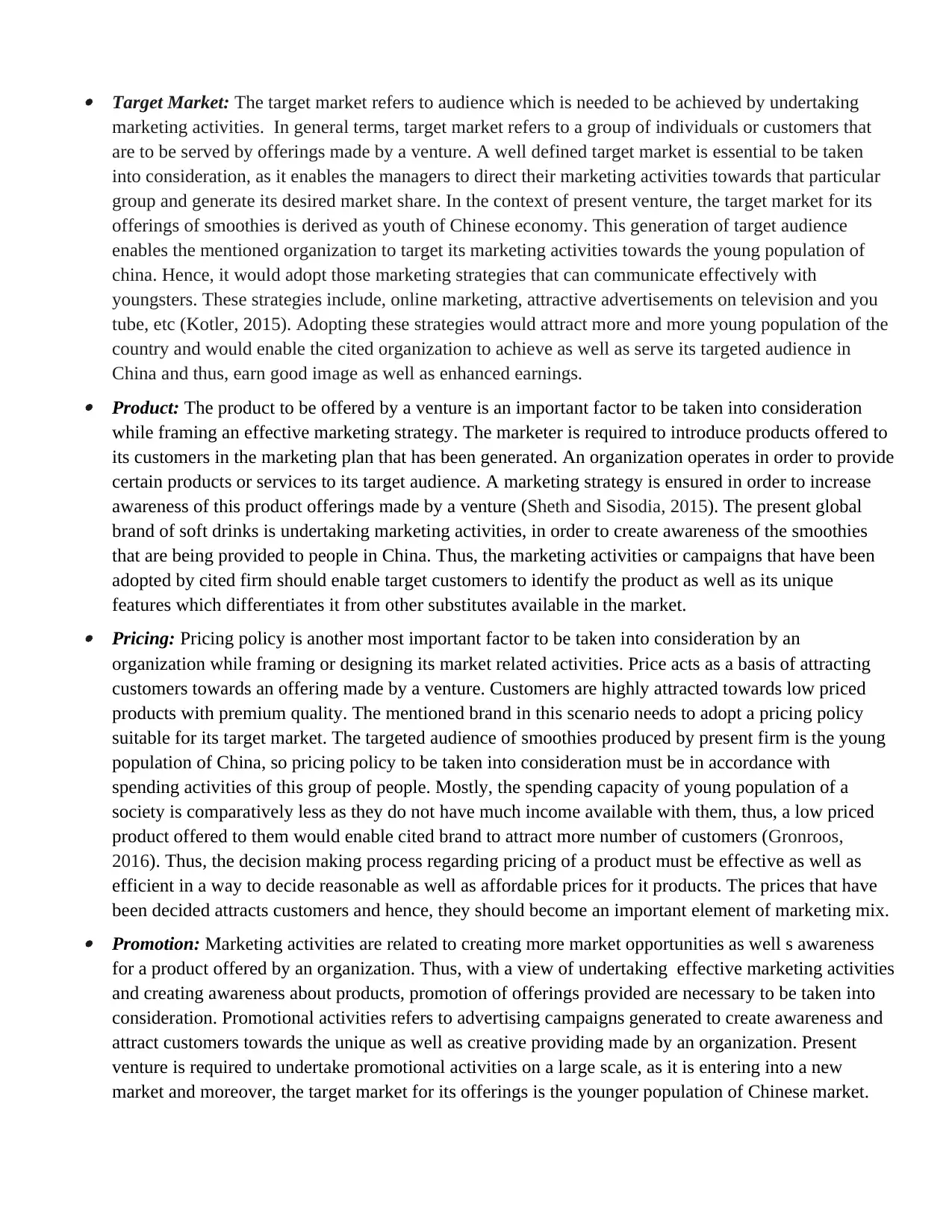
Target Market: The target market refers to audience which is needed to be achieved by undertaking
marketing activities. In general terms, target market refers to a group of individuals or customers that
are to be served by offerings made by a venture. A well defined target market is essential to be taken
into consideration, as it enables the managers to direct their marketing activities towards that particular
group and generate its desired market share. In the context of present venture, the target market for its
offerings of smoothies is derived as youth of Chinese economy. This generation of target audience
enables the mentioned organization to target its marketing activities towards the young population of
china. Hence, it would adopt those marketing strategies that can communicate effectively with
youngsters. These strategies include, online marketing, attractive advertisements on television and you
tube, etc (Kotler, 2015). Adopting these strategies would attract more and more young population of the
country and would enable the cited organization to achieve as well as serve its targeted audience in
China and thus, earn good image as well as enhanced earnings.
Product: The product to be offered by a venture is an important factor to be taken into consideration
while framing an effective marketing strategy. The marketer is required to introduce products offered to
its customers in the marketing plan that has been generated. An organization operates in order to provide
certain products or services to its target audience. A marketing strategy is ensured in order to increase
awareness of this product offerings made by a venture (Sheth and Sisodia, 2015). The present global
brand of soft drinks is undertaking marketing activities, in order to create awareness of the smoothies
that are being provided to people in China. Thus, the marketing activities or campaigns that have been
adopted by cited firm should enable target customers to identify the product as well as its unique
features which differentiates it from other substitutes available in the market.
Pricing: Pricing policy is another most important factor to be taken into consideration by an
organization while framing or designing its market related activities. Price acts as a basis of attracting
customers towards an offering made by a venture. Customers are highly attracted towards low priced
products with premium quality. The mentioned brand in this scenario needs to adopt a pricing policy
suitable for its target market. The targeted audience of smoothies produced by present firm is the young
population of China, so pricing policy to be taken into consideration must be in accordance with
spending activities of this group of people. Mostly, the spending capacity of young population of a
society is comparatively less as they do not have much income available with them, thus, a low priced
product offered to them would enable cited brand to attract more number of customers (Gronroos,
2016). Thus, the decision making process regarding pricing of a product must be effective as well as
efficient in a way to decide reasonable as well as affordable prices for it products. The prices that have
been decided attracts customers and hence, they should become an important element of marketing mix.
Promotion: Marketing activities are related to creating more market opportunities as well s awareness
for a product offered by an organization. Thus, with a view of undertaking effective marketing activities
and creating awareness about products, promotion of offerings provided are necessary to be taken into
consideration. Promotional activities refers to advertising campaigns generated to create awareness and
attract customers towards the unique as well as creative providing made by an organization. Present
venture is required to undertake promotional activities on a large scale, as it is entering into a new
market and moreover, the target market for its offerings is the younger population of Chinese market.
marketing activities. In general terms, target market refers to a group of individuals or customers that
are to be served by offerings made by a venture. A well defined target market is essential to be taken
into consideration, as it enables the managers to direct their marketing activities towards that particular
group and generate its desired market share. In the context of present venture, the target market for its
offerings of smoothies is derived as youth of Chinese economy. This generation of target audience
enables the mentioned organization to target its marketing activities towards the young population of
china. Hence, it would adopt those marketing strategies that can communicate effectively with
youngsters. These strategies include, online marketing, attractive advertisements on television and you
tube, etc (Kotler, 2015). Adopting these strategies would attract more and more young population of the
country and would enable the cited organization to achieve as well as serve its targeted audience in
China and thus, earn good image as well as enhanced earnings.
Product: The product to be offered by a venture is an important factor to be taken into consideration
while framing an effective marketing strategy. The marketer is required to introduce products offered to
its customers in the marketing plan that has been generated. An organization operates in order to provide
certain products or services to its target audience. A marketing strategy is ensured in order to increase
awareness of this product offerings made by a venture (Sheth and Sisodia, 2015). The present global
brand of soft drinks is undertaking marketing activities, in order to create awareness of the smoothies
that are being provided to people in China. Thus, the marketing activities or campaigns that have been
adopted by cited firm should enable target customers to identify the product as well as its unique
features which differentiates it from other substitutes available in the market.
Pricing: Pricing policy is another most important factor to be taken into consideration by an
organization while framing or designing its market related activities. Price acts as a basis of attracting
customers towards an offering made by a venture. Customers are highly attracted towards low priced
products with premium quality. The mentioned brand in this scenario needs to adopt a pricing policy
suitable for its target market. The targeted audience of smoothies produced by present firm is the young
population of China, so pricing policy to be taken into consideration must be in accordance with
spending activities of this group of people. Mostly, the spending capacity of young population of a
society is comparatively less as they do not have much income available with them, thus, a low priced
product offered to them would enable cited brand to attract more number of customers (Gronroos,
2016). Thus, the decision making process regarding pricing of a product must be effective as well as
efficient in a way to decide reasonable as well as affordable prices for it products. The prices that have
been decided attracts customers and hence, they should become an important element of marketing mix.
Promotion: Marketing activities are related to creating more market opportunities as well s awareness
for a product offered by an organization. Thus, with a view of undertaking effective marketing activities
and creating awareness about products, promotion of offerings provided are necessary to be taken into
consideration. Promotional activities refers to advertising campaigns generated to create awareness and
attract customers towards the unique as well as creative providing made by an organization. Present
venture is required to undertake promotional activities on a large scale, as it is entering into a new
market and moreover, the target market for its offerings is the younger population of Chinese market.
Paraphrase This Document
Need a fresh take? Get an instant paraphrase of this document with our AI Paraphraser
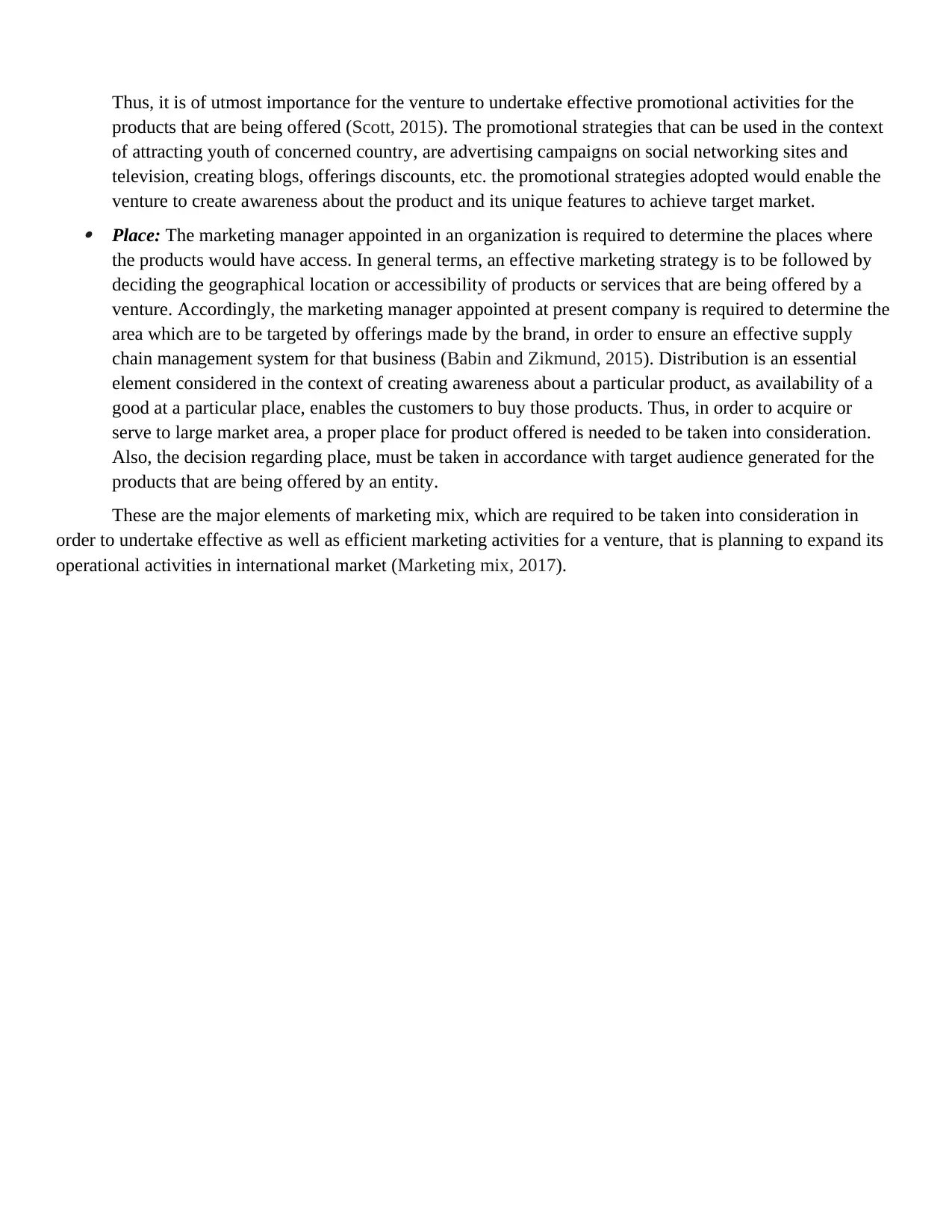
Thus, it is of utmost importance for the venture to undertake effective promotional activities for the
products that are being offered (Scott, 2015). The promotional strategies that can be used in the context
of attracting youth of concerned country, are advertising campaigns on social networking sites and
television, creating blogs, offerings discounts, etc. the promotional strategies adopted would enable the
venture to create awareness about the product and its unique features to achieve target market.
Place: The marketing manager appointed in an organization is required to determine the places where
the products would have access. In general terms, an effective marketing strategy is to be followed by
deciding the geographical location or accessibility of products or services that are being offered by a
venture. Accordingly, the marketing manager appointed at present company is required to determine the
area which are to be targeted by offerings made by the brand, in order to ensure an effective supply
chain management system for that business (Babin and Zikmund, 2015). Distribution is an essential
element considered in the context of creating awareness about a particular product, as availability of a
good at a particular place, enables the customers to buy those products. Thus, in order to acquire or
serve to large market area, a proper place for product offered is needed to be taken into consideration.
Also, the decision regarding place, must be taken in accordance with target audience generated for the
products that are being offered by an entity.
These are the major elements of marketing mix, which are required to be taken into consideration in
order to undertake effective as well as efficient marketing activities for a venture, that is planning to expand its
operational activities in international market (Marketing mix, 2017).
products that are being offered (Scott, 2015). The promotional strategies that can be used in the context
of attracting youth of concerned country, are advertising campaigns on social networking sites and
television, creating blogs, offerings discounts, etc. the promotional strategies adopted would enable the
venture to create awareness about the product and its unique features to achieve target market.
Place: The marketing manager appointed in an organization is required to determine the places where
the products would have access. In general terms, an effective marketing strategy is to be followed by
deciding the geographical location or accessibility of products or services that are being offered by a
venture. Accordingly, the marketing manager appointed at present company is required to determine the
area which are to be targeted by offerings made by the brand, in order to ensure an effective supply
chain management system for that business (Babin and Zikmund, 2015). Distribution is an essential
element considered in the context of creating awareness about a particular product, as availability of a
good at a particular place, enables the customers to buy those products. Thus, in order to acquire or
serve to large market area, a proper place for product offered is needed to be taken into consideration.
Also, the decision regarding place, must be taken in accordance with target audience generated for the
products that are being offered by an entity.
These are the major elements of marketing mix, which are required to be taken into consideration in
order to undertake effective as well as efficient marketing activities for a venture, that is planning to expand its
operational activities in international market (Marketing mix, 2017).
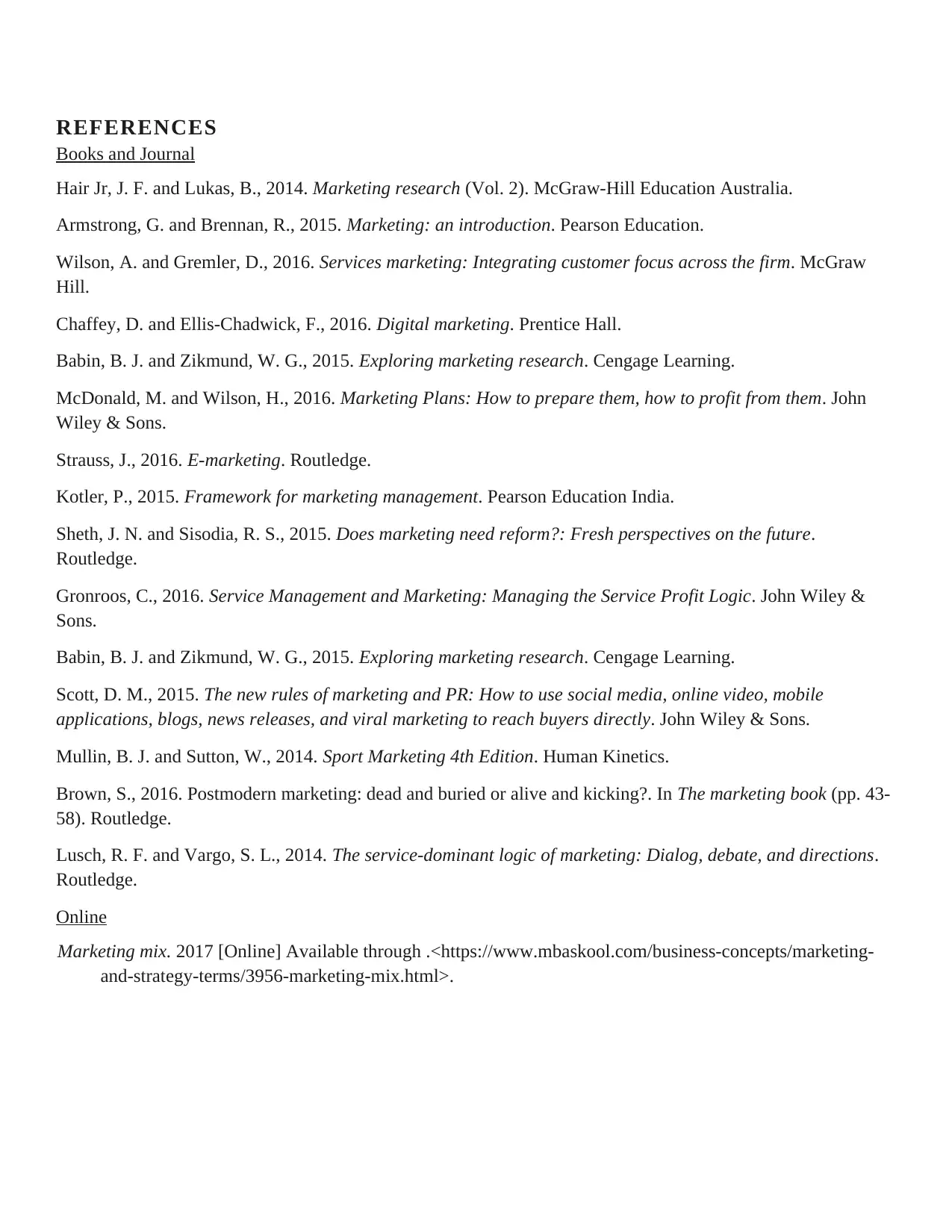
REFERENCES
Books and Journal
Hair Jr, J. F. and Lukas, B., 2014. Marketing research (Vol. 2). McGraw-Hill Education Australia.
Armstrong, G. and Brennan, R., 2015. Marketing: an introduction. Pearson Education.
Wilson, A. and Gremler, D., 2016. Services marketing: Integrating customer focus across the firm. McGraw
Hill.
Chaffey, D. and Ellis-Chadwick, F., 2016. Digital marketing. Prentice Hall.
Babin, B. J. and Zikmund, W. G., 2015. Exploring marketing research. Cengage Learning.
McDonald, M. and Wilson, H., 2016. Marketing Plans: How to prepare them, how to profit from them. John
Wiley & Sons.
Strauss, J., 2016. E-marketing. Routledge.
Kotler, P., 2015. Framework for marketing management. Pearson Education India.
Sheth, J. N. and Sisodia, R. S., 2015. Does marketing need reform?: Fresh perspectives on the future.
Routledge.
Gronroos, C., 2016. Service Management and Marketing: Managing the Service Profit Logic. John Wiley &
Sons.
Babin, B. J. and Zikmund, W. G., 2015. Exploring marketing research. Cengage Learning.
Scott, D. M., 2015. The new rules of marketing and PR: How to use social media, online video, mobile
applications, blogs, news releases, and viral marketing to reach buyers directly. John Wiley & Sons.
Mullin, B. J. and Sutton, W., 2014. Sport Marketing 4th Edition. Human Kinetics.
Brown, S., 2016. Postmodern marketing: dead and buried or alive and kicking?. In The marketing book (pp. 43-
58). Routledge.
Lusch, R. F. and Vargo, S. L., 2014. The service-dominant logic of marketing: Dialog, debate, and directions.
Routledge.
Online
Marketing mix. 2017 [Online] Available through .<https://www.mbaskool.com/business-concepts/marketing-
and-strategy-terms/3956-marketing-mix.html>.
Books and Journal
Hair Jr, J. F. and Lukas, B., 2014. Marketing research (Vol. 2). McGraw-Hill Education Australia.
Armstrong, G. and Brennan, R., 2015. Marketing: an introduction. Pearson Education.
Wilson, A. and Gremler, D., 2016. Services marketing: Integrating customer focus across the firm. McGraw
Hill.
Chaffey, D. and Ellis-Chadwick, F., 2016. Digital marketing. Prentice Hall.
Babin, B. J. and Zikmund, W. G., 2015. Exploring marketing research. Cengage Learning.
McDonald, M. and Wilson, H., 2016. Marketing Plans: How to prepare them, how to profit from them. John
Wiley & Sons.
Strauss, J., 2016. E-marketing. Routledge.
Kotler, P., 2015. Framework for marketing management. Pearson Education India.
Sheth, J. N. and Sisodia, R. S., 2015. Does marketing need reform?: Fresh perspectives on the future.
Routledge.
Gronroos, C., 2016. Service Management and Marketing: Managing the Service Profit Logic. John Wiley &
Sons.
Babin, B. J. and Zikmund, W. G., 2015. Exploring marketing research. Cengage Learning.
Scott, D. M., 2015. The new rules of marketing and PR: How to use social media, online video, mobile
applications, blogs, news releases, and viral marketing to reach buyers directly. John Wiley & Sons.
Mullin, B. J. and Sutton, W., 2014. Sport Marketing 4th Edition. Human Kinetics.
Brown, S., 2016. Postmodern marketing: dead and buried or alive and kicking?. In The marketing book (pp. 43-
58). Routledge.
Lusch, R. F. and Vargo, S. L., 2014. The service-dominant logic of marketing: Dialog, debate, and directions.
Routledge.
Online
Marketing mix. 2017 [Online] Available through .<https://www.mbaskool.com/business-concepts/marketing-
and-strategy-terms/3956-marketing-mix.html>.
⊘ This is a preview!⊘
Do you want full access?
Subscribe today to unlock all pages.

Trusted by 1+ million students worldwide
1 out of 9
Related Documents
Your All-in-One AI-Powered Toolkit for Academic Success.
+13062052269
info@desklib.com
Available 24*7 on WhatsApp / Email
![[object Object]](/_next/static/media/star-bottom.7253800d.svg)
Unlock your academic potential
Copyright © 2020–2025 A2Z Services. All Rights Reserved. Developed and managed by ZUCOL.





